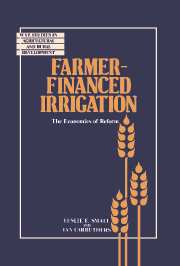1 - Irrigation financing in perspective
Published online by Cambridge University Press: 05 November 2011
Summary
Irrigation in the context of Third World development
Irrigation and world food supplies
Irrigation provides supplementary water supply to one-fifth of the world's cultivated land, from which one-third of the world's food is harvested. Many of the world's poorest people are dependent on this food. Billions of low-income people struggle to supplement inadequate and unreliable rainfall with irrigation.
The stakes are clearly high. Two statistics highlight this. One in five of all people in the world is a Chinese peasant and most of them are irrigation farmers. Every month there are a million more Indian farmers and most are or would like to become irrigation farmers.
Irrigation is a potentially effective investment to service the basic needs for food and employment in the developing world. But the investment necessary to develop new irrigation systems is costly. And the expense does not end with the construction of irrigation facilities. The provision of reliable irrigation service requires recurrent expenditures for operation and maintenance.
Irrigation has been an extremely important development investment area in recent years and it is going to be even more important in the future. In several large developing countries like China, India, Indonesia and Pakistan, half of all agricultural investment goes into irrigation. Some 25–30% of World Bank agricultural lending is allocated to irrigation. In the next 10 years between $50 and $120 billion will be spent on new irrigation and on rehabilitating existing projects.
- Type
- Chapter
- Information
- Farmer-Financed IrrigationThe Economics of Reform, pp. 1 - 13Publisher: Cambridge University PressPrint publication year: 1991

